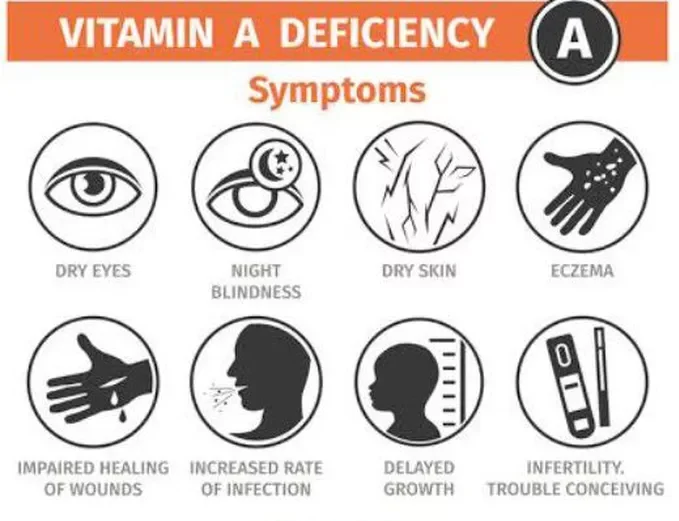Today, we’re going to explore one of the most essential nutrients—Vitamin A.
What is Vitamin A?
Vitamin A is a fat-soluble vitamin, meaning it gets stored in the body’s fat tissues and liver for a long time. Once consumed in sufficient quantity, it can last in the body for extended periods.
Globally, over 30% of children under the age of 5 suffer from Vitamin A deficiency, which is one of the leading causes of preventable blindness in children.
Key Functions of Vitamin A
Vitamin A plays multiple important roles in the body:
-
Supports Vision: Essential for clear and color vision, especially in low light.
-
Boosts Immunity: Strengthens the immune system and helps fight infections.
-
Promotes Reproductive Health: Supports the reproductive systems in both men and women.
-
Maintains Organ Function: Helps in the healthy functioning of the respiratory and gastrointestinal tracts.

Daily Requirements
-
Adults: 700–900 micrograms per day
-
Children: 300–700 micrograms per day
-
Pregnant or breastfeeding women: Need higher intake, but only under medical supervision.
Signs & Symptoms of Vitamin A Deficiency
Vitamin A deficiency is most commonly seen in children. The signs include:
-
Night blindness
-
Dry eyes and skin
-
Frequent infections – cold, cough, diarrhea
-
Corneal damage leading to blindness
-
Poor immunity and slow recovery from illness
What is its function in our body?
- It helps in maintaining our vision and our colour vision. Vitamin A plays a very important role in the process of seeing colour in our eyes.
- Apart from this, it maintains our immunity and keeps our immune function strong.
- It maintains our reproductive health.
- It maintains the health of our respiratory system, which we call respiratory system, and our G.I. system.
Daily Requirement of Vitamin A
Let us know about its daily requirement.
- In healthy adults, its requirement is 700 to 900 micrograms per day.
- In children, its requirement is 300 to 700 micrograms per day.
- Its requirement increases in females and during pregnancy.
Deficiency of Vitamin A
What happens in the body due to deficiency of Vitamin A?
People who have Vitamin A deficiency, generally Vitamin A deficiency is common in children.
Among them, night blindness, which we call raton.
Our eyes start getting dry. Because it plays a very important role in maintaining immunity.
Children or those people, start getting frequent infections. They frequently suffer from cold, cough, diarrhoea and stomach infections. Due to its deficiency, dryness starts occurring in the body, in the skin.

Who is at Risk?
Certain groups are more prone to Vitamin A deficiency:
-
Children under 5 years of age
-
Premature babies
-
Children suffering from diarrhea, malnutrition, or measles
-
People with chronic digestive disorders (e.g., liver, pancreas, or intestinal issues)
Note: Measles can drastically deplete Vitamin A levels in the body. This is why vaccination at 9 months is crucial.

How is Vitamin A Deficiency Treated?

In India and several other countries, Vitamin A supplementation is part of the national immunization program:
-
First dose is given at 9 months
-
Followed by a dose every 6 months until the age of 5
Caution: Pregnant women should not take Vitamin A supplements without a doctor’s advice, as excess intake can cause birth defects (teratogenic effects).

Natural Sources of Vitamin A
There are two primary types of dietary Vitamin A:
1. Animal-Based Sources (Retinol)
These are highly bioavailable and well absorbed (80–100%):
-
Fish and fish liver oil
-
Liver (beef, chicken)
-
Eggs
-
Milk and dairy products
2. Plant-Based Sources (Beta-Carotene)

These contain beta-carotene, a powerful antioxidant that the body converts to Vitamin A:
-
Carrots
-
Sweet potatoes
-
Mangoes
-
Papayas
-
Apricots
-
Red bell peppers
-
Leafy greens (like spinach, kale)
-
Broccoli
The rich orange or green color of these fruits and vegetables often indicates a high beta-carotene content.
Vitamin A for Infants
-
Breast milk provides sufficient Vitamin A for babies up to 6 months of age.
-
Mothers are encouraged to breastfeed exclusively during this time.
When Should You Suspect a Deficiency?
If you experience:
-
Recurrent infections
-
Poor immunity
-
Dryness in the skin or eyes
-
Difficulty seeing in dim light
You may have a Vitamin A deficiency. Instead of taking supplements, first try to increase your intake through natural food sources.